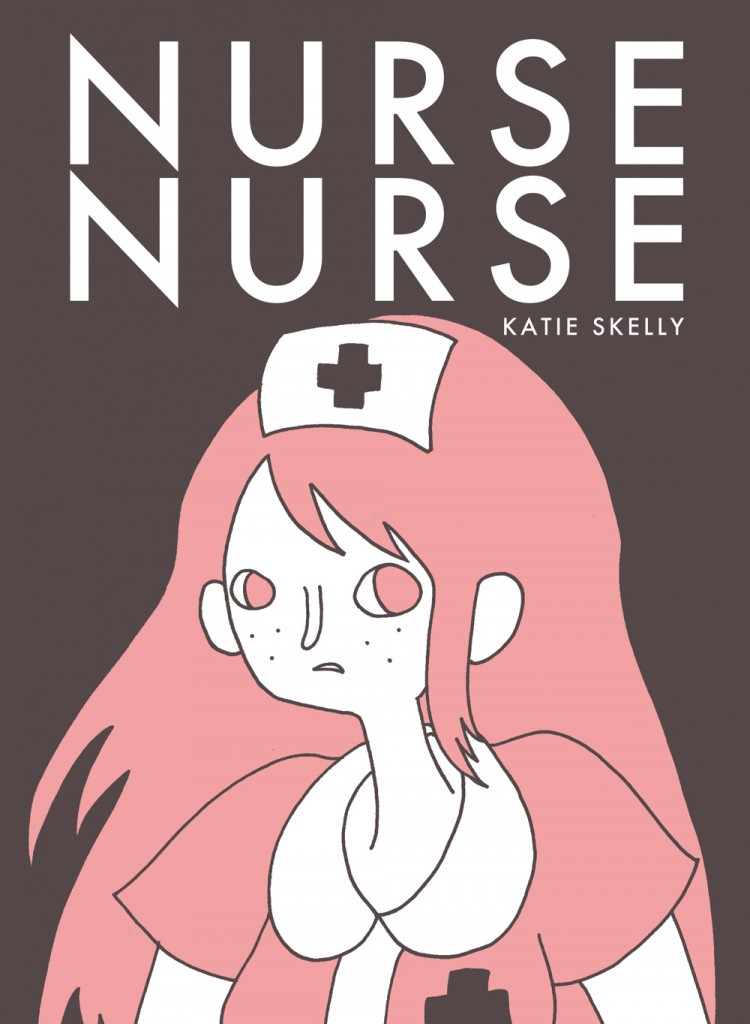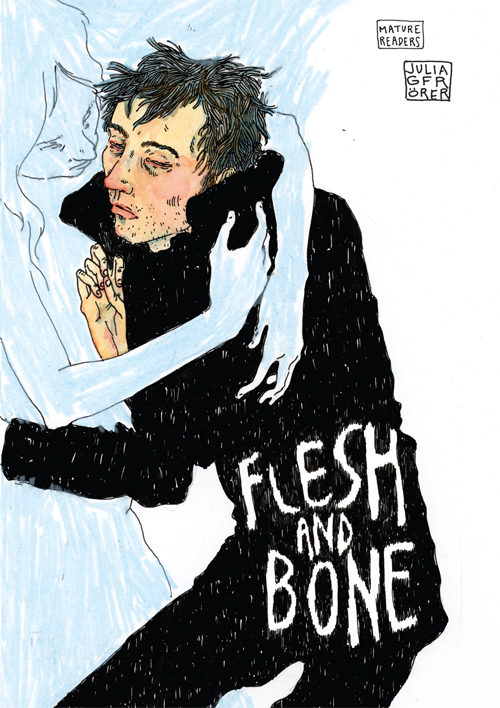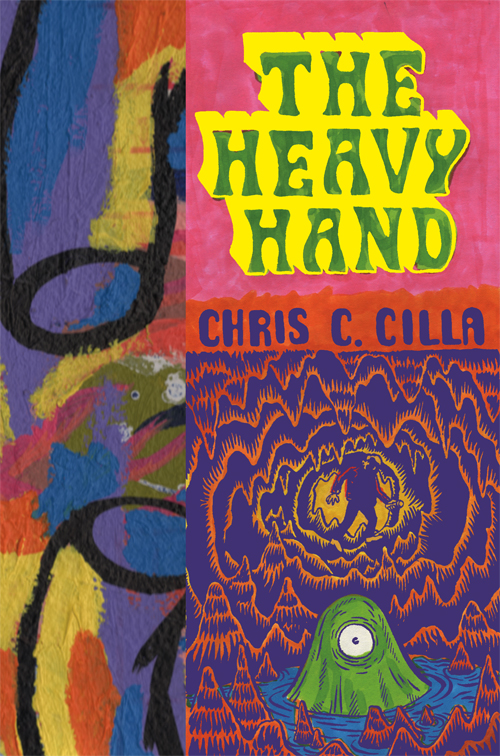Posts Tagged ‘Sparkplug’
Comics Time: Nurse Nurse
June 4, 2012Nurse Nurse
Katie Skelly, writer/artist
Sparkplug, 2012
160 pages
$15
Buy it from Sparkplug
For today’s Comics Time review, please visit The Comics Journal.
Comics Time: Flesh and Bone
November 17, 2011Flesh and Bone
Julia Gfrörer, writer/artist
Sparkplug, 2010
40 pages
$6
Buy it from Sparkplug
Death as an irreparable rupture. Explicit, raw, wounded-animal sexuality. The calculating and casual torture and murder of children. Occult evil that actively belittles the human capacity for love and kindness. It’s tough to think of a darker brew than the one Julia Gfrörer serves in Flesh and Bone, the all too aptly titled tale of a man who’ll do anything to be reunited with his dead beloved and the witch who’s all too happy to accommodate him. But it’s a heady brew, too. Gfrörer’s intelligence shines through in virtually every particular, from pacing (the excruciatingly interminable sequence in which the bereaved man writhes first in agony then in resigned masturbatory ecstasy on his beloved’s grave) to dialogue (a devastating exchange between witch and demon in which love is dismissed as “mutual masturbation,” a form of slavery that prevents humankind from pulling itself out of the muck) to strategic absences of dialogue (a harrowing silent sequence in which an owl is sent to blind a young witness to a horrible crime) to character design (the man’s Byronic good looks, the demon’s disembodied lion head) to facial expression and body language (the witch’s arched back and closed lids as she copulates with a screeching mandrake creature) to a cover that nails the appeal of her wiry, frail characters and line. I can think of few efforts in this vein that impress me, or resonate with me, more deeply than Gfrörer’s. Highly recommended.
Dylan Williams
September 12, 2011Dylan Williams, the publisher of Sparkplug Comic Books, has died of cancer. He was 39.
I didn’t know Dylan like many of the people offering heartfelt tributes did. I knew him to say hello, and we exchanged emails about Sparkplug’s releases from time to time. But I didn’t need to know him to be stunned by this news and to mourn this loss.
Only recently, as Sparkplug has published more work and I’ve read more of it, did I realize how valuable that publisher is to alternative comics, and how singular a role it plays. The visual style of most of the Sparkplug releases I’ve seen is demanding of the audience, and not in any kind of fashionable way that could help get them over. And the intelligence of the writing behind them, even the ones that didn’t necessarily click with me, is really incandescent; more thought and effort has gone into it than might instantly be reciprocated or rewarded by the reading and buying public.
Simply put, I don’t think a home for many of these creators and comics would have existed anywhere if Dylan Williams hadn’t created it. That’s not something I would say about very many other publishers today, even publishers I really love. Sparkplug is one of a kind, and it’s no great leap to suggest that the man behind Sparkplug must have been one of a kind as well.
Chris Mautner has an obituary. Tom Spurgeon has an authoritative list of links. Austin English, Levon Jihanian, Minty Lewis, John Hankiewicz, and Brett Warnock offer moving testimonials to their colleague and friend.
Comics Time: The Heavy Hand
August 10, 2011The Heavy Hand
Chris C. Cilla, writer/artist
Sparkplug, 2010
108 pages
$14.99
Buy it from Sparkplug
Buy it from Amazon.com
Fascinating book, this. It combines the textural, noise-based visual aesthetic of caves and monsters and melty stuff that you may have seen from many of Chris Cilla’s fellow contributors to the Paper Rodeo and Kramers Ergot anthologies with the down’n’out beer-swillin’ shit-talkin’ big-schnozzed characters of ’90s altcomix (big noses are to alternative what big feet were to the underground), so right off the top it’s doing something unexpected. And in the same way that the art is both densely intense and breezily funny, the story somehow coheres from jokey banter, grand-guignol monster attacks, and surreal non sequitur splash pages into an utterly convincing world. The Heavy Hand is basically the tale of Alvin Crabshack, somewhat feckless young guy who picks up stakes and moves from the city to a remote research site in hopes of bluffing his way into the employ of a scientist he admires, at which point he is drawn into a crescendoing series of bizarre science-fictional events — and it works great on both sides of that descriptive sentence’s comma.
Regarding the first half, Cilla’s command of the details of a young life not particularly well lived is substantial. Just for example, look at the way he differentiates between the two women Alvin is (duplicituously) dating by how he dresses both their rooms and themselves — the first has a neat haircut and sits in bed reading one book among many well-ordered shelves, candles and wine glasses strewn here and there; the second we meet as she cracks open a beer and picks a cassette tape off a table sporting a used ashtray and half-eaten dishes, all while bare-ass naked — while giving both sequences a sordid, stiff-nippled sexiness, a squalid heat that comes from lying to someone you know intimately and resent at least as much as you enjoy.
Of course, the second woman has a duck’s beak instead of a nose, which leads us to the strangeness. Obviously this wouldn’t be the first time an alternative comic featured unexplained anthropomorphism in an otherwise realistic setting, so I didn’t pay it much attention — nor the weird, wordless opening sequence in which some kind of ghostly scientist fixes both a machine and a cup of coffee by pissing all over them. But as Alvin’s journey progresses, we come to learn that not only is he basically lying his way into working with his academic idol, but the work he’ll be doing is considerably more odd and dangerous than the book’s opening makes it sound. Rival grant-sponsored teams plumb a system of caverns and underground rivers for giant eggs that contain dead reptiles, while huge and deadly one-eyed protoplasmic creatures devour their pack donkeys…which in turn hearkens back to tall tale about a curse on a nearby town that led to its affliction with these strange animals…which we suddenly realize relates to the odd interstitial splashes and spreads depicting a mustachioed man and giant spiders and so on…which we eventually learn aren’t the non-narrative interruptions they appear to be but an integral part of the story at hand…which culminates in a tour-de-force party sequence where the romantic entanglements and awkward interpersonal interactions of the beginning of the book come back into play. These competing, seemingly clashing narrative and visual threads slowly enmesh and intertwine so organically that you hardly notice, until suddenly you realize they’ve sewn up a structure so sturdy you could spend hours climbing around inside it.
My only complaint is that you don’t get that kind of time. As fun as that party scene is — I really love the way all of the dialogue is disconnected, with never more than two word balloons actually commenting on one another; it’s a great way to convey feeling out of place in an inebriated crowd — it eats up a huge amount of space relative to the densely plotted rest of the book, and rockets everything to its explosive conclusion way too fast. The Lynchian epilogue is as engrossing as anything else in the book, but it made me pine for a nonexistent much longer version, one that didn’t cut itself off right when it became apparent how rich and compelling it was. But since so much of the plot is driven by an anecdote about an inventor whose life basically had to blow up before he could do what would make him rich for the rest of his life, it’s hard for me to get too upset that the book itself follows suit. Wanting more is surely a sign that this smart, biting work of literary science-fiction comics did something right.
Comics Time: Too Dark to See
June 3, 2011Too Dark to See
Julia Gfrörer, writer/artist
Thuban Press, May 2011
32 pages
$5
Buy it from Julia Gfrörer
Buy it from Sparkplug
“I just need your cum. Give it to me and I’ll go away.” Well, hello, sailor! In the vanguard of a burgeoning mini-movement of alternative comics dealing frankly and explicitly with/in sex, Too Dark to See centers on a liaison between a sleepy (or possibly sleeping) young man and a spectral shadow woman, the bluntly transactional nature of which is no doubt hot to some, cold to others. It’s tough to figure out how to feel about it, actually, and that’s what makes it a fine catalyst for the story, which is primarily about the real live human couple of which the guy is a part. His girlfriend, our protagonist through the bulk of the story, is introduced to us as either she or he (it’s not clear who; I’m not sure it matters) says “No one has ever loved anyone more than I love you” as they embrace in bed, but before long she’s being cuckolded by a shadow creature. We next see her sitting on the toilet, naked from the waist down, awkwardly asking the guy if he remembers jerking off in his sleep. She’s at a disadvantage throughout: She thinks her boyfriend might be cheating on her and her suspicion is greeted with angry dismissal, she fails to pick up on cues he thinks are screamingly obvious and interrupts him as he works on writing “the first good idea I’ve had in ages,” she suspects a customer at the coffee shop where she works of coming in solely to judge her, she’s worried about a black spot that could be an STD but which we can gather from our experience with the shadow person is likely something far more sinister, she self-mutilates, she struggles to even be heard at one point while lying under the covers when her boyfriend returns after storming off, and even supernatural entities make fun of her. Factor in Gfrörer’s shaky, wiry line, really perfect for capturing both the undermployed bohemian demimonde and the veal-calf physicality of young skinny naked people, and the feeling that emerges is one of almost overwhelming vulnerability — a woman who feels at the mercy of love, sex, money, class, and her own body, to the point where the addition of dark forces from beyond feels not just appropriate but almost inevitable. It’s an ugly feeling, and it takes a special sort of beauty to capture it as well as this disarming little comic does.
Comics Time: Studygroup12 #4
February 2, 2011Studygroup 12 #4
Zack Soto, Steve Weissman, Eleanor Davis, Michael DeForge, Trevor Alixopulos, T. Edward Bak, Chris Cilla, Max Clotfelter, Farel Dalrymple, Vanessa Davis, Theo Ellsworth, Jason Fischer, Nick Gazin, Richard Han, Jevon Jihanian, Aidan Koch, Amy Kuttab, Blaise Larmee, Corey Lewis, Kiyoshi Nakazawa, Tom Neely, Jennifer Parks, Karn Piana, Jim Rugg, Tim Root, Ian Sundahl, Angie Wang, Dan Zettwoch, writers/artists
Zack Soto, editor
Milo George, editorial/technical advisor
Published by Jason Leivian and Zack Soto, December 2010
80 pages
$20
Buy it from Zack Soto
This is going to come out sounding waaaay more like a diss than it’s intended to, but in flipping through the comeback installment of this Zack Soto-edited alt/artcomix anthology a few weeks after my initial read-through, I realized I didn’t remember anything in it prior to cracking the covers once again. Which is fine, I think! Looking at it now, Studygroup12 #4 seems to me to be much more an art book than a comics anthology. For one thing it’s exquisitely made: Beautiful screenprinted neon-pink-and-aqua covers inside covers (trust me, it’s much glowier than the scan above suggests); a gallery of impactful pink/blue/purple splash pages to kick things off and close things out, including some of the most striking images Jon Vermilyea and Dan Zettwoch have ever constructed out of their customary melty-monster and diagram styles respectively; pages printed in the vivid, inky blue-purple of a carbon copy. It’s a lovely package even compared to the similar approaches of Mould Map and Monster. My point is simply that all these things point to a book that works better from moment to moment as a catalog of images and illustrations rather than one whose strength arises from the cumulative impact of individual sequential narratives. Flipping through, I’m struck by the weird mystical sensuality of Aidan Koch’s portraiture and triangular caption boxes; the Renee-French-on-a-photocopier haze of Jennifer Parks’s creepy little strip; the pleasure of seeing Tom Neely images reproduced at a much larger size than his customary minicomics; the strength of the way Vanessa Davis designs leering faces, something that’s much clearer to me here than its ever been in the comics I’ve seen from her elsewhere, which frankly have never bowled me over the way they have so many readers; some funny punk/thrash/metal/trash pastiches from Vice Magazine’s mustache-at-large Nick Gazin (I wish a HAUNTED HOLOCAUST: “THE TEENAGE TITS TOUR” t-shirt actually existed). But much of what really reads as comics does so rather weakly — an uncharacteristic experimental misfire from Michael DeForge; the return of USApe, my least favorite Jim Rugg character; diminishing returns from Vermilyea’s anthropomorphized breakfast gang, which here get a little too Milk and Cheese-y; a Farel Dalrymple strip that’s drowned out by its over-shading; etc. Ultimately it’s really only Blaise Larmee’s riotously confrontational anxiety-of-influence comic, in which one of his trademark prepubescent/elfin protagonists navigates her way through some sort of abstract geometric maze only to stand in front of a menacing reproduced photograph of Charles Schulz (!!!), that hits me hard as comics; perhaps not coincidentally it’s the first time I’ve seen anything from his whole Comets Comets crew that makes good on their kill-yr-idols gotta-make-way-for-the-homo-superior internet trolling. As a look at the Portland-helmed turn-of-the-decade artcomix look, it’s swell; as a look at their comics, and where they might take everyone else’s, it’s only a start.





